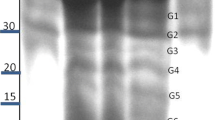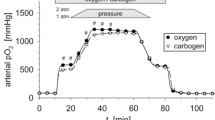Summary
Relative blood flow in different organs of the supralethally (3 kR) whole body X-irradiated rat was studied using labeled 15 µ microspheres. Immediately after irradiation blood flow in brain diminishes. From 10 to 20 hrs a phase of increase in blood flowing to many parenchymal organs ensues. A second maximum 45 to 50 hrs and a third one at 60 hrs. In most organs except in brain and liver relative blood flow diminishes before death. The genesis of these changes as signs of a slowly developing shock is discussed.
Similar content being viewed by others
References
Bock, K. O. (Ed.): Shock Pathogenesis and Therapy. Berlin-Heidelberg-New York: Springer 1962
Bond, V. P., Fliedner, T. M., Archambeau, J. O.: Mammalian Radiation Lethality. New York: Academic Press 1965
Chapman, P. H., Young, R. J.: Effect of Cobalt 60 Gamma irradiation on blood pressure and cerebral blood flow in the macacca mulatta. Radiat. Res.35, 78–85 (1968)
Folkow, B., Neil, E.: Circulation. New York: Oxford University Press 1971
Gerber, G. B., Altman, K. I.: In: Radiation Biochemistry, Vol. II (Altman, K. I., Gerber, G. B., Okada, S.,Ed.). New York: Academic Press 1970
Gerber, G. B., Watters, C.: Untersuchungen zum Mechanismus des gastrointestinalen Syndroms. Berichte der Schutzkommission am Bundesministerium des Inneren, Tagung München, 1974, p. 107–120
Gerber, G. B., Gilliavod, N., Deroo, J.: Renin-angiotensin and aldosterone in the gastrointestinal syndrome after whole body irradiation. Int. J. Radiat. Biol. (in press)
Gits, J., Gerber, G. B.: Electrolyte loss, the main cause of death from the gastrointestinal syndrome. Radiat. Res.55, 18–28 (1973)
Hamilton, W. F., Moore, J. W., Kinsman, J. M., Spurling, R. G.: Studies on the circulation. IV. Further analysis of the injection method and of changes in hemodynamics under physiological and pathological conditions. Amer. J. Physiol.99, 534 (1932)
Holman, B. L., McNiel, B. J., Adelstein, S. J.: Regional blood flow studies with radioisotopes. In: Dynamic studies with radioisotopes in Medicine 1974, Vol. II, p. 3–17. Vienna: IAEA 1975
Kabal, J., Baum, S. J., Parkhurst, L. J.: Canine intestinal vasoactivity during the development of the gastrointestinal syndrome. Radiat. Res.50, 528–538 (1972)
Mendell, P. L., Hollenberg, N. K.: Cardiac output distribution in the rat; comparison of rubidium and microsphere methods. Amer. J. Physiol.22, 1617–1620 (1971)
Mills, L. C., Moyer, J. H. (Ed.): Shock and Hypotension. New York: Grune & Stratton 1965
Nathan, M. A., Craig, D. J.: Effect of high energy X-ray and pulsed Gamma Neutron irradiation on brain blood flow, vascular resistance, blood pressure and heart rate in monkeys. Radiat. Res.50, 543–555 (1972)
Neutze, J. M., Wyler, F., Rudolph, A. M.: Changes to Distribution of Cardiac Output after Hemmorhage in Rabbits. Amer. J. Physiol.215, 857–864 (1968)
Philips, R. D., Kimeldorf, D. J.: The effect of whole body X-irradiation on blood pressure in the rat. Radiat. Res.18, 86–95 (1963)
Rudolph, A. M., Heymann, M. A.: Measurement of flow in perfused organs using microspheres techniques, Karolinska Sympos.,4, Perfusion Techniques, Oct. 11–13, 1971, p. 112–127
Sapirstein, L. A.: Regional blood flow by fractional distribution of indicators. Amer. J. Physiol.193, 161–168 (1958)
Sapirstein, L. A., Sapirstein, E. H., Bredemeyer, A.: Effect of hemorrhage on the cardiac output and its distribution in the rat. Circulat. Res.8, 135–148 (1960)
Sasaki, Y., Wagner, H. N.: Measurement of the distribution of cardiac output in unanaesthetized rats. J. appl. Physiol.30, 879–884 (1971)
Takacs, L., Kallay, K., Skolnik, J. H.: Effect of tourniquet shock and acute hemorrhage on the circulation of various organs in the rat. Circulat. Res.10, 753–757 (1962)
Watters, C., Gerber, G. B.: Renal function and intra/extravascular distribution spaces in the rat after supralethal whole-body X-irradiation. Rad. and Environm. Biophysics12, 291–302 (1975)
Wykoff, M. H.: The effect of fast neutron irradiation on blood pressure and the response to epinephrine and acetylcholine in the rat. Radiat. Res.49, 624–630 (1972)
Wyler, F., Neutze, J. M., Rudolph, A. M.: Effects of Endotoxin on Distribution of Cardiac Output in Unaesthetized Rabbits. Amer. J. Physiol.219, 246–251 (1970)
Zweifach, B. W., Kivy-Rosenberg, E.: Microcirculatory effects of whole body X-irradiation and radiometric procedures. Amer. J. Physiol.208, 492–498 (1965)
Author information
Authors and Affiliations
Additional information
Supported by the Schutzkommission, Publication No. 1050 of the Euratom Biology Division.
Rights and permissions
About this article
Cite this article
Watters, C., Gerber, G.B. Regional blood flow in rats exposed to supralethal doses of whole body X-irradiation. Radiat Environ Biophys 12, 303–313 (1975). https://doi.org/10.1007/BF01323418
Received:
Issue Date:
DOI: https://doi.org/10.1007/BF01323418




